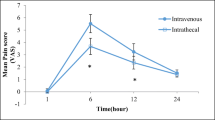Abstract
Purpose. The current study was done to compare the effect of spinal and epidural anesthesia on surgical outcome measures of inguinal herniorrhaphy.
Methods. Ninety-eight male patients undergoing inguinal hernia repair were randomized to either spinal (SA; n = 39) or epidural (EA; n = 59) anesthesia groups anesthetized with either glycosylated bupivacaine (20 mg) or 0.5 % bupivacaine (100 mg). Anesthesia onset time (AOT), postoperative stand-up time (SUT), first pain sensation time (FPT), operation time (OT), analgesic requirement (AR), hospital stay (HS), visual analogue scores of pain (VAS), per- and postoperative complications, and postanesthesia complications were recorded and compared with each other.
Results. FPT was 6.6 ± 0.6 h and 3.1 ± 0.4 h and OT was 40 ± 2 min and 33.1 ± 1 min in the EA and SA groups, respectively (p < 0.05). SUT was also longer in EA group. VAS scores at 12 and 24 h were significantly higher in the EA group (28 ± 4 mm and 24 ± 5 mm in EA and 16 ± 4 and 5 ± 1 mm in SA; P < 0.05). No statistically significant difference was found between the SA and EA groups with respect to the other outcome measures that were considered.
Conclusion. Spinal and epidural anesthesia show some differences from each other with respect to outcome measures such as OT, SUT, FPT, and 12- and 24-h VAS scores.
Similar content being viewed by others
Author information
Authors and Affiliations
Additional information
Received: October 10, 2000 / Accepted: November 30, 2001
About this article
Cite this article
Günal, Ö., Arikan, Y. & Çelikel, N. Clinical assessment of spinal and epidural anesthesia in inguinal hernia repair. J Anesth 16, 119–122 (2002). https://doi.org/10.1007/s005400200005
Issue Date:
DOI: https://doi.org/10.1007/s005400200005




